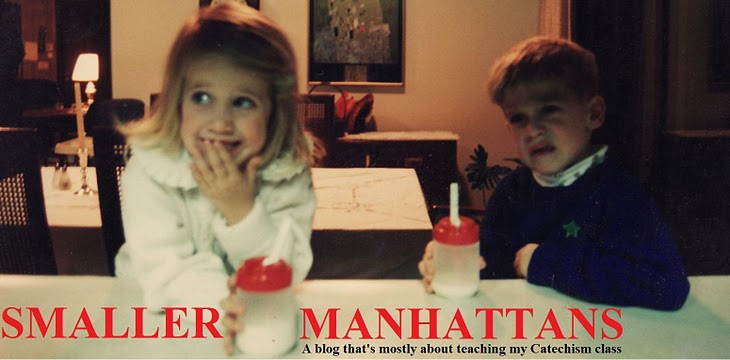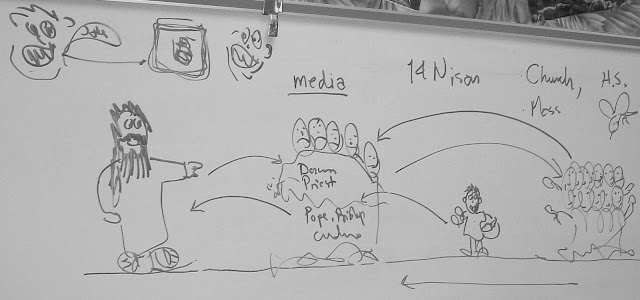You feed 'em!
Partial board from the Jan 25, 2012 class. Lesson plan runs from Feeding the Multitudes to the Bread of Life Discourse, to Simon's name-change to Peter.
Now that Jesus is busy-busy with his ministry, the Gospels run thick and fast with references to the Old Testament. Loaves'n'Fishes is introduced by an edited version of 2Kings 4:42-44:
"42 A man came from Baal-shalishah, bringing the man of God bread of the first fruits, twenty loaves of barley, and fresh ears of grain in his sack. And Elisha said, "Give to the men, that they may eat." 43 But his servant said, "How am I to set this before a hundred men?" So he repeated, "Give them to the men, that they may eat, for thus says the LORD, 'They shall eat and have some left.'" 44 So he set it before them. And they ate, and had some left, according to the word of the LORD."
We also look at Matt 19:13-15 for reasons that become apparent as we get into the Loaves story:
"Then children were brought to him that he might lay his hands on them and pray. The disciples rebuked the people; 14 but Jesus said, "Let the children come to me, and do not hinder them; for to such belongs the kingdom of heaven." 15 And he laid his hands on them and went away."
During Peter-gets-the-Keys, the kids barely recalled Isaiah 22, which we acted out a couple of months ago:
"I will call my servant Eliakim the son of Hilkiah, 21 and I will clothe him with your robe, and will bind your girdle on him, and will commit your authority to his hand; and he shall be a father to the inhabitants of Jerusalem and to the house of Judah. 22 And I will place on his shoulder the key of the house of David; he shall open, and none shall shut; and he shall shut, and none shall open."
Past classes needed little-to-no reminding about Isaiah 22, but this year I almost had to give them the answer, which is anathema to me. Anyway, they finally remembered the key business, but with such coaxing! But the 8 kids who came were tired; and they were guessing like monkeys, which means answering first, then thinking.
On the whole it was still a good class.
Now that Jesus is busy-busy with his ministry, the Gospels run thick and fast with references to the Old Testament. Loaves'n'Fishes is introduced by an edited version of 2Kings 4:42-44:
"42 A man came from Baal-shalishah, bringing the man of God bread of the first fruits, twenty loaves of barley, and fresh ears of grain in his sack. And Elisha said, "Give to the men, that they may eat." 43 But his servant said, "How am I to set this before a hundred men?" So he repeated, "Give them to the men, that they may eat, for thus says the LORD, 'They shall eat and have some left.'" 44 So he set it before them. And they ate, and had some left, according to the word of the LORD."
We also look at Matt 19:13-15 for reasons that become apparent as we get into the Loaves story:
"Then children were brought to him that he might lay his hands on them and pray. The disciples rebuked the people; 14 but Jesus said, "Let the children come to me, and do not hinder them; for to such belongs the kingdom of heaven." 15 And he laid his hands on them and went away."
During Peter-gets-the-Keys, the kids barely recalled Isaiah 22, which we acted out a couple of months ago:
"I will call my servant Eliakim the son of Hilkiah, 21 and I will clothe him with your robe, and will bind your girdle on him, and will commit your authority to his hand; and he shall be a father to the inhabitants of Jerusalem and to the house of Judah. 22 And I will place on his shoulder the key of the house of David; he shall open, and none shall shut; and he shall shut, and none shall open."
Past classes needed little-to-no reminding about Isaiah 22, but this year I almost had to give them the answer, which is anathema to me. Anyway, they finally remembered the key business, but with such coaxing! But the 8 kids who came were tired; and they were guessing like monkeys, which means answering first, then thinking.
On the whole it was still a good class.
















